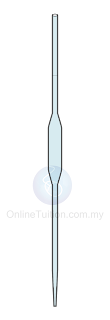Volume Measurement
- Volume is the space occupied by an object.
- The SI unit for volume is cubic metre (m³).
- Millilitre (ml) and litre (l) are used for measuring liquid volumes.
1 ml = 1 cm³,
1 l = 1000 ml = 1000 cm³
1 m³ = 1000 000 cm³
1 m³
= 1m x 1m x 1m
= 100cm x 100cm x 100cm
= 1,000,000 cm³
Measuring the Volume of Liquids
- Liquid volumes can be measured using a measuring cylinder or a burette or a pipette.
- Burette is more accurate than measuring cylinder whereas pipette is more accurate than burette.
- However, a pipette can only measure a fixed amount of liquid, such as 5cm³, 15cm³, 20cm³ or 25cm³.
- A few precaution need to be taken when measuring the volume of a liquid:
- The measuring cylinder must be placed on a level surface and a piece of white paper placed behind it.
- The liquid volume is read from the meniscus level as shown in figure below.
- The meniscus of mercury is curved upwards. The reading has to be taken on top of the curve.
- Burettes and pipettes can measure liquid volumes more accurately than measuring cylinders because:
- The volume of liquid released from the burette can be measured as the difference between the final and initial readings.
| Measuring Cyclinder | Burette | Pipette |
Measuring Volume of Solids
- The volume of regular or irregular shaped solids can be measured using the water displacement method.
Example:
- Another method to measure volume of irregular solids is by using the eureka can.







0 comments:
Post a Comment